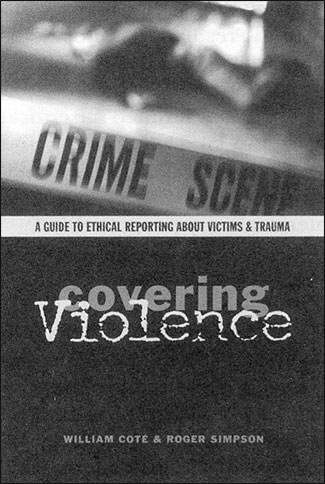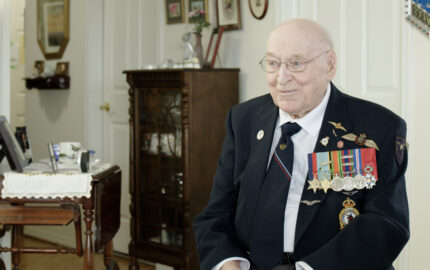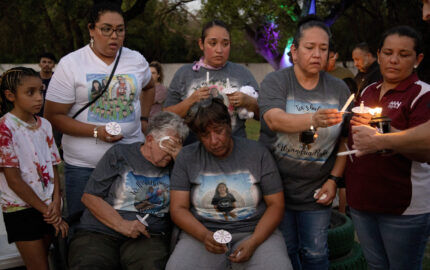It’s our fifth year of the Dart Center for Journalism and Trauma and, by now, we have as our guide a mantra that goes like this: “Training. Support during the assignment. Post-assignment support.” To us this means working hard to train reporters how to do journalism that involves violence and work equally hard to train news organizations how to support them while they are doing it and after.
The basic ideas emerge out of a decade of observing closely how journalists and news organizations respond to the coverage of violence at home and in other countries. Our approach reflects what we’ve learned in thousands of conversations with reporters, photographers, editors and human resources directors, and include insights gained in discussions among journalists and mental health professionals in places as diverse as Papua New Guinea, South Africa, and Croatia as part of the work of the Dart Center. At the Dart Center, this effort rests on two simple and connected beliefs.
These convictions emerged for me during 20 years of seeking an ethical way for journalism to be practiced in an era of extensive media attention to violence. They also underscore the commitment of the Dart Foundation, which provides the largest part of our funding, as well as that of Frank Ochberg, a psychiatrist whose vision won our loyalty in the early 1990’s and has guided us steadily since. (Ochberg brought the University of Washington and the Dart Foundation together to establish the Dart Center in Seattle in 1999.)
Learning About Trauma
By 1999, when we set up the center, the University of Washington journalism faculty had been teaching students about trauma and about interviewing victims of violence for six years. We also had talked with Oklahoma City journalists who’d covered the bombing of the federal building there that killed 168 people and injured 853 others. The staff of The Oklahoman, that city’s daily newspaper, helped me grasp a defining characteristic of journalism at the millennium: An event—a bombing, a school shooting, an act of terror—shatters the security of a community and changes its focus immediately. As time goes on, the event and its aftermath remain a story that won’t go away.
Journalists in communities of all sizes know this. One weary reporter on a small city daily told us about beginning each day of reporting in the aftermath of a violent event feeling as though she had to jump into a wild, raging river and swim across it. Everyday, the image she saw was the same. In describing this, she spoke for many of the journalists in Oklahoma City, as well as for those in Denver (who reported on the Columbine shootings) and reporters in many other cities where school shootings killed adults and youngsters. She also gave us an understanding about what reporters were going through on September 11, 2001 in New York, Washington, D.C., and Shanksville, Pennsylvania.
The story doesn’t go away. And it chews at the vitality of those who must cover it day after day.
More recent tragic events make clear what we should have learned from the experiences of veterans of 20th century wars—how exposure to trauma creates emotional wounds that need help to heal. Military personnel who suffered trauma in combat in Korea, Vietnam, the first Gulf War, and other actions often still endure the pain of their emotional wounds. Just as some Vietnam veterans found it difficult to pull back from the endlessly televised scenes of September 11th, firefighters in New York today are drawn by their own traumas to the troubling scenes of death and destruction in Iraq shown on television news.
Posttraumatic stress disorder (PTSD), a condition that physicians can diagnose and treat, was not taken seriously by the journalism craft before 1999. In 1996, I conducted the first research on trauma among journalists. At that time, no one knew if, how or how much journalists were affected emotionally by events they covered. It seemed as though everyone assumed that journalists were immune to emotional injuries. Since 1999, a series of studies has given us a rough benchmark reading on how reporters and photographers are affected. These findings affirm the resiliency of most journalists, while showing that some have lasting emotional effects from their work. They also underlined the critical absence of the kinds of training and support received by other first-respond-ers to violent events—police, firefighters, military personnel.
Training Journalists
RELATED ARTICLE
"Resources for Reporting on Violence"
- Roger SimpsonFor the Dart Center, the training mission plays out in several ways. We help newsroom managers and professional organizations train employees and members about traumatic injury and self-care. We’ve provided workshops for National Public Radio, The Newspaper Guild, Society of Professional Journalists, the Unity Convention, the Houston Chronicle, and others. Although we have been asked to respond to particular tragic events, we emphasize training to prepare for the possibility of covering such events. The center also regards college journalism teachers as key agents in the training mission, so in 2003 it began offering a series of seminars to help college instructors shape a reporting curriculum so that students can use trauma knowledge in their reporting. Each year, we train six or more mid-career journalists in a five-day seminar. These reporters keep us honest by relentlessly asking us to show them how to interview, write and investigate better, given this newfound knowledge about trauma.
Teachers must cope with similar barriers to dealing with trauma as those that confront many editors. Teachers and newsroom managers share an impatience when it comes to expressions of emotion. Teachers work at suppressing emotional reactions in classrooms in the interest of imparting ideas or information. In the newsroom, emotions are often ignored or viewed as indications of weakness.
At the University of Washington, we employ professional actors to help raise the emotional intensity in sessions on interviewing to a level that promotes—indeed, ensures—learning. The actors are trained to present a wide range of emotions likely to be found in persons at the scene of a tragedy—struggling to speak, frightened, angry, tearful, desperate for information. Confronting an emotional person, the student must find a way to communicate both humanely and productively. In the debriefing that follows each interview, students are encouraged to speak about how their own emotions surface, and the discussion leads to useful collective reflections on handling them.
We will continue to invest in promoting effective training in college classrooms until the news industry turns seriously to providing consistent training programs about trauma for staff journalists. When we began our work, the expressions of resistance from newsroom managers persuaded us to place our bets on the long-term benefits of better college training. Today, with the overt industry resistance fading, the way is open to encourage better training efforts by news corporations.
News Organizations: Training and Support
A sterling example is the British Broadcasting Corp. (BBC), which prepared for the 2003 Iraq invasion with the first training of war-bound correspondents to help them recognize and manage trauma reactions. The BBC, like much of the industry, also provides hostile-environment training and counseling services for staff and family. But trauma was the new and significant element in the run-up to the war.
The Iraq experience showed numerous good efforts by news organizations to keep in touch with journalists, whether they were embedded or operating independently of the military. Newsrooms developed effective, sensitive ways of responding to colleagues caught in the storm of war. Journalist helped journalist by staying in touch, relaying news, listening for signs of stress or anxiety. The more thoughtful editors embraced families as well as staffers in their attention to emotional needs.
It’s a sad fact, though, that this well-deserved attention now given to training war and international correspondents isn’t being shared with domestic reporters, whose daily work may also entail close encounters with the victims of violence, threats to personal safety, and exhausting concentration on stories that never seem to end. Journalists readily share with us their frustration about this. Recently, a reporter told of being sent into a neighborhood riot where her car was torched and a colleague injured. She had had no training for such dangers and had little support at the scene. After the incident, when she needed attention, editors’ concerns had moved on, leaving her with scant appreciation for the risks she’d taken to tell this story.
Indeed, the post-assignment needs of frontline journalists receive far too little attention even after terrorism and the Iraq War have emphasized the lingering effects of doing journalism under stressful conditions. The BBC now conducts a pre-assignment assessment of its correspondents and then follows their return with regular interviews, aimed at spotting signs of trauma effects. But we suspect that few organizations offer follow-up support other than the invitation to seek out confidential counseling.
The absence of that support is costing news media in terms of staff energy, productivity and morale. Ultimately, the public pays that cost in the reporting we rely on for knowledge of our community, nation and world. Granted, we don’t have a good measure of the gap between the work of a journalist adequately supported and one whose managers look the other way after the stress is past. It is a commonsense response, though, to urge greater attention to those who suffer stress and trauma on our behalf.
Among journalists, one group struggles harder than the others to deal with the effects of trauma: Television and electronic journalists struggle against industry indifference to the longer-term effects of their work and against the unremitting pressure of assignments. In our workshops, we hear repeatedly about these pressures and the sense, whether justified or not, that managements do not want to open the door to discussion of the effects of assignments. Such conversation could help the editors, like one in Seattle who dispatched a father who had recently lost a child to cover the Oklahoma City bombing, or like another who sent a reporter who had lost a loved one in a plane crash to cover the aftermath of a plane crash.
After five years, though, there is pleasure in knowing that opportunities for enhancing the training and support of journalists are increasing steadily. And they are doing so, in part, because more editors are connecting their ability to respond to the needs of their reporters to the ultimate benefit of the public by providing good and consistent stories.
Roger Simpson is the executive director of the Dart Center for Journalism and Trauma at the University of Washington and associate professor in that school’s communication department. He is coauthor of “Covering Violence: A Guide to Ethical Reporting About Victims and Trauma.”
The basic ideas emerge out of a decade of observing closely how journalists and news organizations respond to the coverage of violence at home and in other countries. Our approach reflects what we’ve learned in thousands of conversations with reporters, photographers, editors and human resources directors, and include insights gained in discussions among journalists and mental health professionals in places as diverse as Papua New Guinea, South Africa, and Croatia as part of the work of the Dart Center. At the Dart Center, this effort rests on two simple and connected beliefs.
- Journalism about violence and its victims will best inform readers and viewers when the reporting reflects a solid understanding of the rapidly developing science of traumatic, or emotional, injury.
- The most creative and productive journalists will be those who understand trauma and know how to cope with it for themselves and for co-workers.
These convictions emerged for me during 20 years of seeking an ethical way for journalism to be practiced in an era of extensive media attention to violence. They also underscore the commitment of the Dart Foundation, which provides the largest part of our funding, as well as that of Frank Ochberg, a psychiatrist whose vision won our loyalty in the early 1990’s and has guided us steadily since. (Ochberg brought the University of Washington and the Dart Foundation together to establish the Dart Center in Seattle in 1999.)
Learning About Trauma
By 1999, when we set up the center, the University of Washington journalism faculty had been teaching students about trauma and about interviewing victims of violence for six years. We also had talked with Oklahoma City journalists who’d covered the bombing of the federal building there that killed 168 people and injured 853 others. The staff of The Oklahoman, that city’s daily newspaper, helped me grasp a defining characteristic of journalism at the millennium: An event—a bombing, a school shooting, an act of terror—shatters the security of a community and changes its focus immediately. As time goes on, the event and its aftermath remain a story that won’t go away.
Journalists in communities of all sizes know this. One weary reporter on a small city daily told us about beginning each day of reporting in the aftermath of a violent event feeling as though she had to jump into a wild, raging river and swim across it. Everyday, the image she saw was the same. In describing this, she spoke for many of the journalists in Oklahoma City, as well as for those in Denver (who reported on the Columbine shootings) and reporters in many other cities where school shootings killed adults and youngsters. She also gave us an understanding about what reporters were going through on September 11, 2001 in New York, Washington, D.C., and Shanksville, Pennsylvania.
The story doesn’t go away. And it chews at the vitality of those who must cover it day after day.
More recent tragic events make clear what we should have learned from the experiences of veterans of 20th century wars—how exposure to trauma creates emotional wounds that need help to heal. Military personnel who suffered trauma in combat in Korea, Vietnam, the first Gulf War, and other actions often still endure the pain of their emotional wounds. Just as some Vietnam veterans found it difficult to pull back from the endlessly televised scenes of September 11th, firefighters in New York today are drawn by their own traumas to the troubling scenes of death and destruction in Iraq shown on television news.
Posttraumatic stress disorder (PTSD), a condition that physicians can diagnose and treat, was not taken seriously by the journalism craft before 1999. In 1996, I conducted the first research on trauma among journalists. At that time, no one knew if, how or how much journalists were affected emotionally by events they covered. It seemed as though everyone assumed that journalists were immune to emotional injuries. Since 1999, a series of studies has given us a rough benchmark reading on how reporters and photographers are affected. These findings affirm the resiliency of most journalists, while showing that some have lasting emotional effects from their work. They also underlined the critical absence of the kinds of training and support received by other first-respond-ers to violent events—police, firefighters, military personnel.
Training Journalists
RELATED ARTICLE
"Resources for Reporting on Violence"
- Roger SimpsonFor the Dart Center, the training mission plays out in several ways. We help newsroom managers and professional organizations train employees and members about traumatic injury and self-care. We’ve provided workshops for National Public Radio, The Newspaper Guild, Society of Professional Journalists, the Unity Convention, the Houston Chronicle, and others. Although we have been asked to respond to particular tragic events, we emphasize training to prepare for the possibility of covering such events. The center also regards college journalism teachers as key agents in the training mission, so in 2003 it began offering a series of seminars to help college instructors shape a reporting curriculum so that students can use trauma knowledge in their reporting. Each year, we train six or more mid-career journalists in a five-day seminar. These reporters keep us honest by relentlessly asking us to show them how to interview, write and investigate better, given this newfound knowledge about trauma.
Teachers must cope with similar barriers to dealing with trauma as those that confront many editors. Teachers and newsroom managers share an impatience when it comes to expressions of emotion. Teachers work at suppressing emotional reactions in classrooms in the interest of imparting ideas or information. In the newsroom, emotions are often ignored or viewed as indications of weakness.
At the University of Washington, we employ professional actors to help raise the emotional intensity in sessions on interviewing to a level that promotes—indeed, ensures—learning. The actors are trained to present a wide range of emotions likely to be found in persons at the scene of a tragedy—struggling to speak, frightened, angry, tearful, desperate for information. Confronting an emotional person, the student must find a way to communicate both humanely and productively. In the debriefing that follows each interview, students are encouraged to speak about how their own emotions surface, and the discussion leads to useful collective reflections on handling them.
We will continue to invest in promoting effective training in college classrooms until the news industry turns seriously to providing consistent training programs about trauma for staff journalists. When we began our work, the expressions of resistance from newsroom managers persuaded us to place our bets on the long-term benefits of better college training. Today, with the overt industry resistance fading, the way is open to encourage better training efforts by news corporations.
News Organizations: Training and Support
A sterling example is the British Broadcasting Corp. (BBC), which prepared for the 2003 Iraq invasion with the first training of war-bound correspondents to help them recognize and manage trauma reactions. The BBC, like much of the industry, also provides hostile-environment training and counseling services for staff and family. But trauma was the new and significant element in the run-up to the war.
The Iraq experience showed numerous good efforts by news organizations to keep in touch with journalists, whether they were embedded or operating independently of the military. Newsrooms developed effective, sensitive ways of responding to colleagues caught in the storm of war. Journalist helped journalist by staying in touch, relaying news, listening for signs of stress or anxiety. The more thoughtful editors embraced families as well as staffers in their attention to emotional needs.
It’s a sad fact, though, that this well-deserved attention now given to training war and international correspondents isn’t being shared with domestic reporters, whose daily work may also entail close encounters with the victims of violence, threats to personal safety, and exhausting concentration on stories that never seem to end. Journalists readily share with us their frustration about this. Recently, a reporter told of being sent into a neighborhood riot where her car was torched and a colleague injured. She had had no training for such dangers and had little support at the scene. After the incident, when she needed attention, editors’ concerns had moved on, leaving her with scant appreciation for the risks she’d taken to tell this story.
Indeed, the post-assignment needs of frontline journalists receive far too little attention even after terrorism and the Iraq War have emphasized the lingering effects of doing journalism under stressful conditions. The BBC now conducts a pre-assignment assessment of its correspondents and then follows their return with regular interviews, aimed at spotting signs of trauma effects. But we suspect that few organizations offer follow-up support other than the invitation to seek out confidential counseling.
The absence of that support is costing news media in terms of staff energy, productivity and morale. Ultimately, the public pays that cost in the reporting we rely on for knowledge of our community, nation and world. Granted, we don’t have a good measure of the gap between the work of a journalist adequately supported and one whose managers look the other way after the stress is past. It is a commonsense response, though, to urge greater attention to those who suffer stress and trauma on our behalf.
Among journalists, one group struggles harder than the others to deal with the effects of trauma: Television and electronic journalists struggle against industry indifference to the longer-term effects of their work and against the unremitting pressure of assignments. In our workshops, we hear repeatedly about these pressures and the sense, whether justified or not, that managements do not want to open the door to discussion of the effects of assignments. Such conversation could help the editors, like one in Seattle who dispatched a father who had recently lost a child to cover the Oklahoma City bombing, or like another who sent a reporter who had lost a loved one in a plane crash to cover the aftermath of a plane crash.
After five years, though, there is pleasure in knowing that opportunities for enhancing the training and support of journalists are increasing steadily. And they are doing so, in part, because more editors are connecting their ability to respond to the needs of their reporters to the ultimate benefit of the public by providing good and consistent stories.
Roger Simpson is the executive director of the Dart Center for Journalism and Trauma at the University of Washington and associate professor in that school’s communication department. He is coauthor of “Covering Violence: A Guide to Ethical Reporting About Victims and Trauma.”




